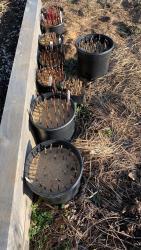I very much appreciate the responses, thank you.
This was an older post, and at the time I was perhaps overly optimistic of my success. Many of these hardwood cuttings leafed out, but later died. The cuttings that did survive (roughly 8 months now), I will wait to pot until next Spring.
To answer your question HighDesertNatives, I do use a rooting hormone and vary the concentration based upon the type of cutting. Your insight in both this thread and my most recent thread were very helpful! As you can see in the photo, my outdoor "bed" is comprised of pots. This was my first attempt at hardwood cuttings, which resulted in mixed success.
I'm having a lot more success with my softwood and semi-hardwood cuttings, but the Pro-mix is definitely more prone to creating rot and mold issues in my propagation domes. I think I'll use coarse sand the next time around.
I hadn't noticed the lenticels on my viburnum cuttings, but that may be because I'm sticking them too close to the surface (?). The first real indication of rooting (that I notice) is the development of new leaves. I severely prune the larger leaved cultivars when I stick them, so I cheer the emergence of new growth.

This is my first year and I am learning, clearly some are easier than others. I am amazed what a difference just a few weeks can have on the success of the late Spring/ early Summer cuttings. I did one pot of Pragense Viburnums with zero success, but a few weeks later every one of my Prague cuttings rooted fine.
Again, many thanks for your comments, I appreciate your insight!

